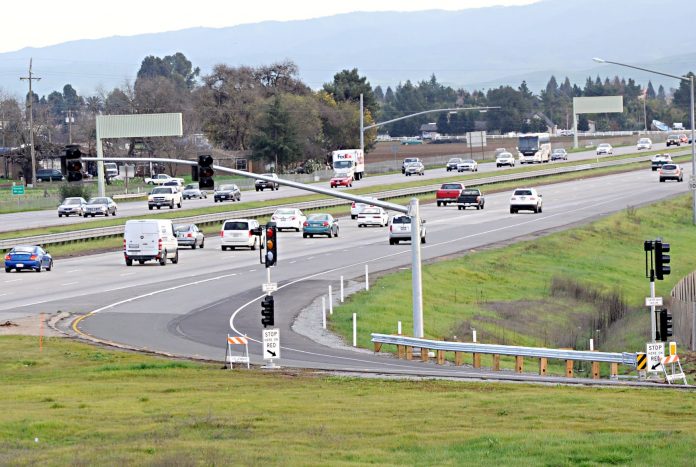
GILROY—U.S. 101 on-ramp meters in Gilroy and Morgan Hill installed earlier this year will be activated in mid-October, according to officials with the California Department of Transportation. It’s part of an $18 million effort to manage traffic bottlenecks on freeways throughout the region during peak commuting hours.
Carpool lanes and meters were installed along widened on-ramps in Gilroy at Monterey Road, 10th Street, Leavesley Road and Masten Avenue. All 17 meters between Gilroy, Morgan Hill and south San Jose are scheduled for activation next month and expected to cut between 2.5 and 7 minutes from commuters’ trips on the freeway, Caltrans Senior Transportation Planner Lester Lee said.
The meters on the northbound lanes of U.S. 101 will be on from 5 a.m. to 9 a.m. Southbound meters will be on from 3 p.m. to 7 p.m. Mondays through Thursdays, and from 2:30 p.m. to 7 p.m. on Fridays, according to Lee.
“Motorists will wait anywhere from a few seconds to three minutes at Gilroy onramps. We’re metering pretty fast down here,” Lee said. The average wait time at Gilroy on-ramps during peak commuting hours will be around 30 seconds, he added.
However, drivers entering the northbound lanes of U.S. 101 from the Monterey Street on-ramp between 5 and 5:15 p.m. will be the “most impacted” with an expected 3-minute delay, Lee said.
It’s those delays that have some councilmembers worried about complaints they expect to get from residents.
When Lee and representatives from the Santa Clara Valley Transportation Authority presented details of the project to the Gilroy City Council on Sept. 14, four on the council vocalized their concerns.
“I’m not happy with this at all. I just don’t think it’s needed for Gilroy,” Councilwoman Cat Tucker said of the meters and widened on-ramps. “We butt heads (with drivers in Morgan Hill at the Cochrane Road exit) but I’ve never seen a backup at any of these on the northbound lanes.”
“There are going to be complaints. There will be emails to me and others, probably more to me, wondering ‘why am I waiting so long if there’s no traffic?’” said Councilman Perry Woodward, who serves as chair of the VTA Board of Directors.
Engineers with Caltrans and VTA will monitor traffic at the local on-ramps via six closed-circuit traffic surveillance cameras. They will also coordinate with the city’s transportation engineer, according to representatives from the agencies.
“We’re trying to make sure that any queues that build up from the meters don’t affect local street operations or block lanes,” said VTA Senior Transportation Planner David Kobayashi. “A key component is making sure we don’t disproportionately add delays to communities along the corridor.”
Mayor Don Gage asked if, in the event there is no traffic on the freeway, there was any way to shut the meters off. He described driving southbound from San Jose and, on multiple occasions, stopping at the meters despite no visible backup in traffic.
Sensors built within the on-ramps will detect congestion levels, and if the freeway is clear during peak hours, the meters “may drop out of metering,” Lee said.
He later explained that Caltrans and VTA will be studying the entire 17-meter network in early 2016 and may adjust the meters’ timing based on how traffic flows in October.
“We may adjust the operating hours based on what we observe,” Lee said.
Additionally, Caltrans will be installing signs at metered on-ramps with a phone number motorists can call with complaints or concerns.
The state agency will respond to complaints from cities along the transportation corridor within 24 to 48 hours, Lee said, and will come up with “some kind of solution” within a month.
Councilman Roland Velasco said he had a tough time “seeing the need” for meters anywhere in the city, describing his daily commute that takes him to the northbound lanes of U.S. 101 via the Masten Avenue or San Martin Avenue on-ramps.
The 17-meter network is in line with Caltrans policy, Lee said, and will help manage congestion as it occurs further north toward Morgan Hill. A San Jose-based staff monitors 210 other meters in Santa Clara County, he added.
Moving forward, Gage said he expects more discussion on the matter.
“I’m sure we’ll have a lot of questions as we get into this,” he remarked. “We’ll certainly get a lot of phone calls, and we’ll be calling (Caltrans).”












